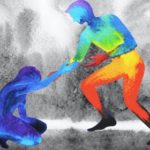by Sam Mowe An Interview with David Haskell…
We interact with trees as strangers because we don’t know their stories. When we listen, we “unself” ourselves— and open to great beauty.
In his first book, The Forest Unseen, David Haskell returned again and again to the same square meter of old-growth Tennessee forest to discern some of the stories that were present there. His new book, The Songs of Trees, uses the same approach with particular trees located in radically different environments—to see how some of the themes in our relationships with trees play out across the world. We spoke with Haskell recently about the practice of listening to trees, why it’s important that we humans understand ourselves as part of the natural world, and how all of life is embedded within networks of relationships that become clear when we “unself” ourselves.
S&H: How do you listen to trees?
David Haskell: Listening involves paying attention to the acoustics of the tree itself—the sound of wind in its leaves, the sound of rain in its leaves, and so forth. These sounds reveal the form of the tree. A maple tree is going to have a very different sound in the wind than a pine tree, and in different seasons the tree will have different voices, revealing some of its physiology and nature.
The sounds of the tree also involve the other creatures that are using the tree—insects, birds, and so forth. You must attend to those sounds, as well. And then humans are another creature, of course, whose lives are intimately connected with trees, whether we’re aware of that fact or not. So part of the listening process involves talking to people whose lives are intertwined with trees, in an effort to discern some of the threads of stories that connect us.
Then, on occasion, I’ve also used some electronic gadgetry to hear ultrasound inside the trees—to hear the sway, bend, and crackle of vibrations flowing through the wood. These are sounds that our unaided ears can’t detect.

Humans are such a visual species. Can you give some examples of what listening can reveal about trees that our eyes cannot detect?
Sound travels around things, through things, and up through the ground in ways that light doesn’t. It’s very easy to block light, to shield from view what is happening, but it’s not so easy to shield sound. In urban trees, in particular, a lot of the vibratory energy—a lot of the sound—comes up through the ground from subway trains, trucks, and so forth. Those sounds enter the tree through the ground in a way you can’t see. If you were standing there just looking, you would have no idea that there was a whole acoustic world of energy below the ground. By listening to the tree—both with ears and by putting a hand on the trunk to experience those vibrations—I can understand something about the nature of the city and how it is changing the tree in a way I can’t understand through the visual sense. Also, using ultrasonic detectors, I can hear some of the internal dynamics of tree twigs as water moves through them—cracks, fizzles, and pops—without which the tree might appear as a stationary, inert, almost dead object. In fact, a tree is a living creature full of minute-by-minute changes. This truth is revealed in the acoustic realm, but not always in the visual realm.
In both The Songs of Trees and your previous book, The Forest Unseen, you pay close attention to trees. However, I gather that it’s not just paying attention that’s important to your project but paying sustained attention to trees. In that way, your work reminds me of the common instruction in many contemplative practices to return again and again to an object of awareness—often the breath. Do you see your project of paying close, sustained attention to trees as a kind of contemplative practice?
Yes, there are very strong parallels between what I’m doing and many contemplative practices in different religious or philosophical traditions. And I do draw on them for guidance. Of course, these practices take very different forms in different traditions, but there’s often an element of repeated attention. In my case, it’s attention sustained over many months and years—a commitment to return again and again to particular places to try to open my senses to them and listen to sounds and stories present at each place.
In an ecological context, sustained attention reveals more dimensions of the story at each place. A tree on the streets of New York has a very different set of sounds and challenges in January than it does in, say, July. From the perspective of a writer and someone who’s trying to learn something about trees in the world, this practice of sustained attention lets me get a little bit below the surface of what we can discover on our first few visits. Of course, I’m also different on each visit. The extended period of observation also reveals something about how we change in relation, how I change in relation to the tree.
Speaking of trees on the streets of New York City, in preparation for this conversation I took a walk around my Brooklyn neighborhood and tried to listen to some of the trees I encountered. I couldn’t hear them over the cars driving past me.
Well, then, actually you did hear the trees. The energy from those cars was entering the trees and changing their growth form—the trees grow thicker wood in response to all of that vibratory energy from the cars. Also, the air quality around you was mediated by the trees—they were absorbing particulates from all that traffic—so the air entered your body in a very different way. In hearing the sounds of cars in your neighborhood—just as one might hear the sound of birds in a rain forest—we are noticing the ways in which we and the cars are part of the tree’s network, part of its world. So by hearing the cars, we are also hearing the tree and ourselves, because every inhalation brings us directly into contact with the exchange between the trees and the internal combustion engines.
It might surprise some people that you just compared the sound of cars in the city to the sound of birds in the rain forest. One idea that you really push back against in The Songs of Trees is the notion that humanity is somehow separate from the rest of nature.
Yes, I think the city is natural. It’s a product of the mind of a particular primate, and so, in dwelling in the city, we inhabit the natural world; the city is one branch of the tree of life and is an expression of its creativity, its joys, and its brokenness. We’re fully within nature when we’re walking down a city street, even if we can’t see any other species. Of course, it’s an experience of nature that is very much simplified in its biological diversity, because we’re interacting primarily with one species, whereas if we’re walking, say, in a temperate forest we’ll often pass hundreds and hundreds of species in a few minutes’ time.
We are not just composed of human cells, we are microbiologically living communities.
Given that we don’t experience as much biological diversity in the city, do you have any tips for city dwellers who want to have deeper relationships with the nonhuman world?
Well, there are some other species present in the city, and ecological relationships exist there. The practice of noticing, knowing, and naming those species can lead to deeper relationships with them. You might make an inventory of the species that live in a particular neighborhood and notice how people are relating to them. What are their stories? Where did they come from? Are they native species or did they come from elsewhere? And if they came from elsewhere, who brought them to this place? What were their stories back in their home countries?
Other species are often in the background of our experience. When we engage in these kinds of exercises, non-human species become a little bit foregrounded. We often interact with trees on the street as strangers because we don’t know their stories. Learning their stories is one way to deepen a connection with them in the city. It often takes an act of will to learn these stories because, in general, cities present trees as passive, municipal objects that are completely stripped of their stories. We need to swim upstream against that tide to find their stories and, therefore, start to belong to each other.
It seems that this exercise of finding stories would deepen our relationship with nonhuman species in certain intellectual and emotional ways, but it strikes me as important that you also engage in sensory practices to foster more-embodied relationships with trees.
Yes, that’s right. The other way in, of course, is to open our senses to other species. What is the texture of the bark on the trees? How do their smells change through the seasons? For example, when the linden trees are blooming in New York, the streets with linden trees smell completely different from those without them. I’m thinking, particularly, of some of the neighborhoods in Harlem. For just a few days, the smell of the flowers of this European tree just permeate the environment, and then it’s all gone.
There’s always some kind of transition happening, and when we pay attention to these changes we can bring that story into our lives through our senses, and therefore, of course, into our minds and bodies.

When you write about humanity not being separate from the rest of nature, it seems worth pointing out that, even though we are natural, the destruction we bring on nonhuman species and ecosystems is massive, and we can choose to live in less destructive ways. Can you comment on that?
I agree that the question that we need to answer is: How should we live? The fact that humans are part of the community of life in no way removes the moral responsibility from us. In no way does it mean that we have as little responsibility for life on earth as a meteorite flying through space. It does mean, however, that we might approach the question of responsibility differently than we would if we believe ourselves to be alien and apart from the rest of nature. If we believe we are fundamentally different in some way, we might come to a different answer about human responsibility than we might if we are working from the premise of human belonging.
There is also an important distinction to make between saying something is natural and saying that it’s beautiful or right. That’s an error of logic that surrounds us these days. Whenever we go to the store, nature is used as a way of convincing us that a particular product is good for us. And, in fact, there are lots of broken things in the community of life—lots of poisons and other things that we, as humans, might choose to turn away from. Understanding ourselves as natural can be a good foundation for beginning to answer the question of how we should live.
You write, “Although tree trunks seemingly stand as detached individuals, their lives subvert this atomistic view. We’re all—trees, humans, insects, birds, bacteria—pluralities. Life is embodied network.” Can you talk about the confusion that arises from understanding ourselves—and trees—as separate individuals rather than as embedded in networks?
Yes, trees seem to be wonderful examples of the atomism that has dominated biological thinking now for at least 150 years. By atomism, I mean the notion that the fundamental unit of life is the self. This is, of course, a very powerful and fruitful view. It allows us to understand many aspects of life. However, it’s an incomplete view and, in some ways, it’s an illusion. Each one of those individuals is, in fact, a manifestation of relationship and connection.
A complementary view of biology is that the fundamental unit of life is not the atom or self. In fact, it isn’t a unit at all; it’s a process. It’s a set of relationships. In this view, life isn’t interconnected; it is made from interconnection. Life isn’t networked; it is network.
When we tilt our heads that way, we have a different notion of what the ground of being is within biology. That sounds very mystical, but I mean it in the most physically grounded way possible. There are networks of biochemistry, genetics, physiology, ecology, and so on. Trees are a great example of this. Pluck a leaf from a tree. That leaf seems to be of a particular species. We give it an atomistic name—say, the sugar maple. And yet that sugar maple is, in fact, a living community of hundreds of species. The leaf has hundreds of species of bacteria within it, and dozens of species of fungi within it. If those species are taken away—if the relationships between the fungi, bacteria, and plant cells within the leaf end—the leaf’s life also ends. It can’t defend itself from pathogens. It can’t withstand drought. The same is true in tree roots.
And the same is true of the human body. We are not just composed of human cells, we are microbiologically living communities. There are hundreds of different species of cells to make a human cell, so our seeming individuality or self also emerges from community. This notion of networks is changing how we think about biology on many different levels.
Along similar lines, one term that you use in The Songs of Trees is “unself.” For example, you write that we can “unself” ourselves into trees and birds. Can you describe that experience?
Yes, this is a term from Iris Murdoch, who wrote about the experience of beauty. She said that beauty could be found in the sight of a bird flying, or when we respond to human art. She called this process of experiencing beauty “an unselfing,” by which she meant we’re drawn out of the limitations of our mind, senses, and imagination, and drawn into another place. In the case of watching a bird flying, we can be drawn into the lived reality of a completely different species.
In the context of networks, we can think of unselfing as our ability to experience other parts of our network. This process is a transcendent experience because it allows us to transcend the limits of our own minds and emotions. In that expansion, perhaps we can find some ethical insight on the question of how we should live.
This Isn’t Complicated
Pick a tree.
Commit to return to it again and again.
Bring an enthusiastic openness of your senses to the tree.
Don’t think this will lead to enlightenment, insight, or sacrament.
Try to visit the tree in various weather conditions.
Notice how different people interact with the tree.
Notice your own thoughts and experiences.
“Listening involves paying attention to the acoustics of the tree itself—the sound of wind in its leaves, the sound of rain in its leaves, and so forth. These sounds reveal the form of the tree.”
About the Author
Sam Mowe is a writer living in Portland, Oregon. His interviews have also appeared in Tricycle: The Buddhist Review, and The Sun. He is also the editor of Lineages, a publication of the Garrison Institute. Sam is a regular contributor to Spirituality & Health.










































